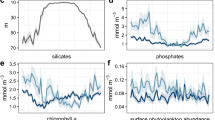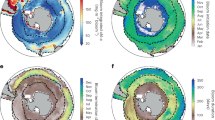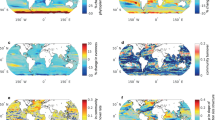Abstract
Seasonal cycles of primary production (phenology) critically influence biogeochemical cycles, ecosystem structure and climate. In the oceans, primary production is dominated by microbial phytoplankton that drift with currents, and show rapid turnover and chaotic dynamics, factors that have hindered understanding of their phenology. We used all available observations of upper-ocean phytoplankton concentration (1995–2015) to describe global patterns of phytoplankton phenology, the environmental factors that structure them, and their relationships to terrestrial patterns. Phytoplankton phenologies varied strongly by latitude and productivity regime: those in high-production regimes were governed by insolation, whereas those in low-production regimes were constrained by vertical mixing. In eight of ten ocean regions, our findings contradict the hypothesis that phytoplankton phenologies are coherent at basin scales. Lastly, the spatial organization of phenological patterns in the oceans was broadly similar to those on land, suggesting an overarching effect of insolation on the phenology of primary producers globally.
This is a preview of subscription content, access via your institution
Access options
Access Nature and 54 other Nature Portfolio journals
Get Nature+, our best-value online-access subscription
$29.99 / 30 days
cancel any time
Subscribe to this journal
Receive 12 digital issues and online access to articles
$119.00 per year
only $9.92 per issue
Buy this article
- Purchase on Springer Link
- Instant access to full article PDF
Prices may be subject to local taxes which are calculated during checkout






Similar content being viewed by others
References
Randerson, J. T., Field, C. B., Fung, I. Y. & Tans, P. P. Increases in early season ecosystem uptake explain recent changes in the seasonal cycle of atmospheric CO2 at high northern latitudes. Geophys. Res. Lett. 26, 2765–2768 (1999).
Boyd, P. W. & Newton, P. P. Evidence of the potential influence of planktonic community structure on the interannual variability of particulate carbon flux. Deep Sea Res. Part I 42, 619–639 (1995).
Eviner, V. T., Chapin, F. S., Vaughn, C. E., Chapin, F. S. III & Vaughn, C. E. Seasonal variations in plant species effects on soil N and P dynamics. Ecology 87, 974–986 (2006).
Inouye, D. W., Barr, B., Armitage, K. B. & Inouye, B. D. Climate change is affecting altitudinal migrants and hibernating species. Proc. Natl Acad. Sci. USA 97, 5–8 (2000).
Post, E. et al. Climate change reduces reproductive success of an Arctic herbivore through trophic mismatch. Phil. Trans. R. Soc. Lond. B. Biol. Sci 363, 2369–2375 (2008).
Platt, T., Fuentes-Yaco, C. & Frank, K. T. Spring algal bloom and larval fish survival. Nature 423, 398–399 (2003).
Rathcke, B. & Lacey, E. P. Phenological patterns of terrestrial plants. Annu. Rev. Ecol. Syst. 16, 179–214 (1985).
Worm, B. et al. Impacts of biodiversity loss on ocean ecosystem services. Science 314, 787–90 (2006).
Vantrepotte, V. & Mélin, F. Inter-annual variations in the SeaWiFS global chlorophyll a concentration (1997–2007). Deep Sea Res. Part I 58, 429–441 (2011).
Boyce, D. G., Dowd, M., Lewis, M. R. & Worm, B. Estimating global chlorophyll changes over the past century. Prog. Oceanogr. 122, 163–173 (2014).
Boyce, D. G., Lewis, M. R. & Worm, B. Global phytoplankton decline over the past century. Nature 466, 591–596 (2010).
Gregg, W. W., Conkright, M. E., Ginoux, P., O’Reilly, J. E. & Casey, N. W. Ocean primary production and climate: global decadal changes. Geophys. Res. Lett. 30, 1809 (2003).
Boyce, D. G. & Worm, B. Patterns and ecological implications of historical marine phytoplankton change. Mar. Ecol. Prog. Ser. 534, 251–272 (2015).
Buitenwerf, R., Rose, L. & Higgins, S. I. Three decades of multi-dimensional change in global leaf phenology. Nat. Clim. Change 5, 364–368 (2015).
Fu, Y. H. et al. Declining global warming effects on the phenology of spring leaf unfolding. Nature 526, 104–107 (2015).
Fridley, J. D. Extended leaf phenology and the autumn niche in deciduous forest invasions. Nature 485, 359–362 (2012).
Field, C. B., Behrenfeld, M. J. & Randerson, J. T. Primary production of the biosphere: integrating terrestrial and oceanic components. Science 281, 237–240 (1998).
Falkowski, P. & Ravens, J. A. Aquatic Photosynthesis (Blackwell Science, 1997).
Benincà, E. et al. Chaos in a long-term experiment with a plankton community. Nature 451, 822–825 (2008).
Demarcq, H., Reygondeau, G., Alvain, S. & Vantrepotte, V. Monitoring marine phytoplankton seasonality from space. Remote Sens. Environ. 117, 211–222 (2012).
Racault, M. F., Le Quéré, C., Buitenhuis, E., Sathyendranath, S. & Platt, T. Phytoplankton phenology in the global ocean. Ecol. Indic. 14, 152–163 (2012).
D’Ortenzio, F., Antoine, D., Martinez, E. & Ribera d’Alcalà, M. Phenological changes of oceanic phytoplankton in the 1980s and 2000s as revealed by remotely sensed ocean-color observations. Global Biogeochem. Cycles 26, 1–16 (2012).
Sapiano, M. R. P., Brown, C. W., Schollaert Uz, S. & Vargas, M. Establishing a global climatology of marine phytoplankton phenological characteristics. J. Geophys. Res. Ocean 117, 1–16 (2012).
Morán, X. A. G. et al. Increasing importance of small phytoplankton in a warmer ocean. Global Change Biol 16, 1137–1144 (2010).
Burnham, K. P. & Anderson, D. R. Model Selection and Multi-Model Inference: A Practical Information-Theoretic Approach (Springer, 2002).
Moore, C. M. et al. Processes and patterns of oceanic nutrient limitation. Nat. Geosci. 6, 1–10 (2013).
Wright, S. S. Correlation and causation. J. Agric. Res 20, 557–585 (1921).
Schimel, D. S. et al. Climate and nitrogen controls on the geography and timescales of terrestrial biogeochemical cycling. Global Biogeochem. Cycles 10, 677 (1996).
Hastie, T. & Tibshirani, R. Generalized additive models. Stat. Sci. 1, 297–318 (1986).
Vargas, M., Brown, C. W. & Sapiano, M. R. P. Phenology of marine phytoplankton from satellite ocean color measurements. Geophys. Res. Lett. 36, 2–6 (2009).
Behrenfeld, M. J. et al. Annual boom–bust cycles of polar phytoplankton biomass revealed by space-based lidar. Nat. Geosci. 10, 118–122 (2017).
Kaufman, L. & Rousseeuw, P. J. Finding Groups in Data: An Introduction to Cluster Analysis (Wiley, 1990).
Sournia, A. Cycle annuel du phytoplancton et de la production primaire dans les mers tropicales. Mar. Biol. 3, 287–303 (1969).
Longhurst, A. Seasonal cooling and blooming in tropical oceans. Deep Sea Res. Part I 40, 2145–2165 (1993).
Lumpkin, R. & Johnson, G. C. Global ocean surface velocities from drifters: mean, variance, El Nino–Southern Oscillation response, and seasonal cycle. J. Geophys. Res. 118, 2922–3006 (2013).
Behrenfeld, M. J., Boss, E., Siegel, D. A. & Shea, D. M. Carbon-based ocean productivity and phytoplankton physiology from space. Global Biogeochem. Cycles 19, 1–14 (2005).
Falkowski, P. G. & Wilson, C. Phytoplankton productivity in the North Pacific ocean since 1900 and implications for absorption of anthropogenic CO2. Nature 358, 741–743 (1992).
Lewandowska, A. M. et al. Effects of sea surface warming on marine plankton. Ecol. Lett. 17, 614–623 (2014).
O’Connor, M. I., Piehler, M. F., Leech, D. M., Anton, A. & Bruno, J. F. Warming and resource availability shift food web structure and metabolism. PloS Biol. 7, 1–6 (2009).
Grace, J. B. Structural Equation Modeling in Natural Systems (Cambridge Univ. Press, 2006).
Marra, J. & Moore, T. S. Monsoons, islands, and eddies: their effects on phytoplankton in the Indian Ocean. Geophys. Monogr. Ser 185, 57–70 (2009).
Boyce, D. G., Frank, K. T. & Leggett, W. C. From mice to elephants: overturning the ‘one size fits all’ paradigm in marine plankton food chains. Ecol. Lett. 18, 504–515 (2015).
Reich, P. B. Phenology of tropical forests: patterns, causes, and consequences. Can. J. Bot 73, 164–174 (1995).
Menzel, A., von Vopelius, J., Estrella, N., Schleip, C. & Dose, V. Farmers’ annual activities are not tracking the speed of climate change. Clim. Res 32, 201–207 (2006).
Winder, M. & Cloern, J. E. The annual cycles of phytoplankton biomass. Phil. Trans. R. Soc. Lond. B Biol. Sci 365, 3215–3226 (2010).
Capone, D. G., Zehr, J. P., Paerl, H. W., Bergman, B. & Carpenter, E. J. Trichodesmium, a globally significant marine cyanobacterium. Science 276, 1221–1229 (1997).
Jickells, T. D. et al. Global iron connections between desert dust, ocean biogeochemistry, and climate. Science 308, 67–71 (2005).
Russel, G., Jarvis, P. G. & Monteith, J. L. Plant Canopies: Their Growth, Form and Function (Cambridge Univ. Press, 1989).
Webb, T. J. Marine and terrestrial ecology: unifying concepts, revealing differences. Trends Ecol. Evol. 27, 535–541 (2012).
Tyler, J. E. The Secchi disk. Limnol. Oceanogr. 13, 1–6 (1968).
Collier, A., Finlayson, G. M. & Cake, E. W. On the transparency of the sea. Limnol. Oceanogr. 13, 391–394 (1968).
Batten, S. D. et al. CPR sampling: the technical background, materials and methods, consistency and comparability. Prog. Oceanogr. 58, 193–215 (2003).
Forel, F. A. Une nouvelle forme de la gamme de couleur pour l’etude de l’eau des lacs. Arch. Sci. Phys. Nat. Phys./Soc. Phys. d’Hist. Nat. Genève 6 (1890).
Harvey, H. W. Measurement of phytoplankton population. J. Mar. Biol. Assoc. UK 19, 761–73 (1934).
Geider, R. J. Light and temperature-dependence of the carbon to chlorophyll-a ratio in microalgae and cyanobacteria — implications for physiology and growth of phytoplankton. New Phytol. 106, 1–34 (1987).
Behrenfeld, M. J. et al. Revaluating ocean warming impacts on global phytoplankton. Nat. Clim. Change 6, 1–27 (2015).
Jeffrey, S. W., Mantoura, R. F. C. & Wright, S. W. Phytoplankton Pigments in Oceanography. Monographs on Oceanographic Methodology 10 (UNESCO, 1997).
Boyce, D. G. D. G., Lewis, M. & Worm, B. Integrating global chlorophyll data from 1890 to 2010. Limnol. Oceanogr. Methods 10, 840–852 (2012).
Hovis, W. A. et al. Nimbus-7 coastal zone color scanner: system description and initial imagery. Science 210, 60–63 (1980).
McClain, C. R., Feldman, G. C. & Hooker, S. B. An overview of the SeaWiFS project and strategies for producing a climate research quality global ocean bio-optical time series. Deep Sea Res. II 51, 5–42 (2004).
Moriarty, R. & O’Brien, T. D. Distribution of mesozooplankton biomass in the global ocean. Earth Syst. Sci. Data 5, 45–55 (2013).
Casey, K. S., Brandon, T. B. & Cornillon, P. in Oceanography from Space: Revisited 1–375 (Springer, 2010).
Ingleby, B. & Huddleston, M. Quality control of ocean temperature and salinity profiles — historical and real-time data. J. Mar. Syst 65, 158–175 (2007).
Li, W. K. W. Macroecological patterns of phytoplankton in the northwestern North Atlantic Ocean. Nature 419, 154–157 (2002).
Behrenfeld, M. J. et al. Climate-driven trends in contemporary ocean productivity. Nature 444, 752–755 (2006).
Fairall, C. W. et al. Cool-skin and warm-layer effects on sea surface temperature. Geophys. Res. Lett. 101, 1295–1308 (1996).
Wood, S. N. Generalized Additive Models: An Introduction with R (Chapman & Hall/CRC, 2006).
Johnson, J. B. & Omland, K. S. Model selection in ecology and evolution. Trends Ecol. Evol. 19, 101–108 (2004).
Burnham, K. P. & Anderson, R. P. Multimodel inference: understanding AIC and BIC in model selection. Sociol. Methods Res 33, 261–304 (2004).
Hartigan, J. A. & Hartigan, P. M. The dip test of unimodality. Ann. Stat 13, 70–84 (1985).
Myers, R. A., Mertz, G. & Bridson, J. M. Spatial scales of interannual recruitment variations of marine, anadromous, and freshwater fish. Can. J. Fish. Aquat. Sci. 54, 1400–1407 (1997).
Frank, K. T., Petrie, B., Leggett, W. C. & Boyce, D. G. Large scale, synchronous variability of marine fish populations driven by commercial exploitation. Proc. Natl Acad. Sci. USA 113, 8248–8253 (2016).
Duffy, J. E. et al. Biodiversity mediates top-down control in eelgrass ecosystems: a global comparative-experimental approach. Ecol. Lett. 18, 696–705 (2015).
Mora, C. et al. Global human footprint on the linkage between biodiversity and ecosystem functioning in reef fishes. PLoS Biol. 9, e1000606 (2011).
Sugihara, G. et al. Detecting causality in complex ecosystems. Science 338, 496–500 (2012).
Pearl, J. Causal inference in statistics: an overview. Stat. Surv 3, 96–146 (2009).
Behrenfeld, M. J. Abandoning Sverdrup’s critical depth hypothesis on phytoplankton blooms. Ecology 91, 977–89 (2010).
Rosseel, Y. Lavaan: an R package for structural equation modeling. J. Stat. Softw 48, 1–36 (2012).
Petit, J. R. et al. Climate and atmospheric history of the past 420,000 years from the Vostok ice core, Antarctica. Nature 399, 429–436 (1999).
Shipley, B. The AIC model selection method applied to path analytic models compared using a d-separation test. Ecology 94, 560–564 (2013).
Michael J. Behrenfeld. Abandoning Sverdrup’s Critical Depth Hypothesis on phytoplankton blooms. Ecology 91, (4): 977–989 (2010).
Acknowledgements
We thank all data providers, and N. Yoccoz and K. Ellingson for statistical advice and critical feedback. Funding was provided by the Natural Sciences and Engineering Research Council of Canada (NSERC).
Author information
Authors and Affiliations
Contributions
D.G.B. and B.W. initiated the study. D.G.B. compiled the data, conducted the analyses and wrote the manuscript. B.P., K.T.F. and W.C.L. assisted with the analyses, and all authors discussed the results and edited the manuscript.
Corresponding author
Ethics declarations
Competing interests
The authors declare no competing financial interests.
Additional information
Publisher’s note: Springer Nature remains neutral with regard to jurisdictional claims in published maps and institutional affiliations.
Electronic supplementary material
Supplementary Information
Supplementary Tables, Supplementary Figures, Supplementary Analyses and Supplementary Methods
Rights and permissions
About this article
Cite this article
Boyce, D.G., Petrie, B., Frank, K.T. et al. Environmental structuring of marine plankton phenology. Nat Ecol Evol 1, 1484–1494 (2017). https://doi.org/10.1038/s41559-017-0287-3
Received:
Accepted:
Published:
Issue Date:
DOI: https://doi.org/10.1038/s41559-017-0287-3
This article is cited by
-
Coastal phytoplankton blooms expand and intensify in the 21st century
Nature (2023)
-
Linking extreme seasonality and gene expression in Arctic marine protists
Scientific Reports (2023)
-
Picophytoplankton phenology in the global ocean assessed by quantitative niche models
Marine Biology (2022)
-
Evaluating tropical phytoplankton phenology metrics using contemporary tools
Scientific Reports (2019)
-
How self-regulation, the storage effect, and their interaction contribute to coexistence in stochastic and seasonal environments
Theoretical Ecology (2019)



